Word Embedding: Word2Vec Explained
The Word2Vec technique is based on a feed-forward, fully connected architecture. Learn exactly how it works by looking at some examples with KNIME.
Join the DZone community and get the full member experience.
Join For FreeThis post is an extract from Chapter 6 of the book From Words to Wisdom. An Introduction to Text Mining with KNIME by V. Tursi and R. Silipo, to be published in March 2018 by the KNIME Press. The book will be premiered at the KNIME Summit in Berlin in March.
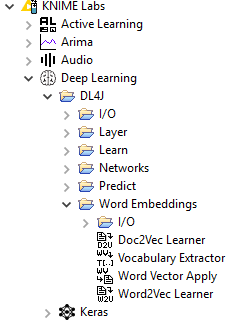
Word embedding, like document embedding, belongs to the text preprocessing phase — specifically, to the part that transforms a text into a row of numbers.
In the KNIME Text Processing extension, the Document Vector node transforms a sequence of words into a sequence of 0/1 — or frequency numbers — based on the presence/absence of a certain word in the original text. This is also called one-hot encoding. One-hot encoding, though, has two big problems:
- It produces a very large data table with the possibility of a large number of columns.
- It produces a very sparse data table with a very high number of 0s, which might be a problem for training certain machine learning algorithms.
The Word2Vec technique was therefore conceived with two goals in mind:
- Reduce the size of the word encoding space (embedding space).
- Compress in the word representation the most informative description for each word.
Interpretability of the embedding space becomes secondary.
Word2Vec Embedding
Neural Architectures
The Word2Vec technique is based on a feed-forward, fully connected architecture. Let’s start with a simple sentence like “the quick brown fox jumped over the lazy dog” and let’s consider the context word by word. For example, the word “fox” is surrounded by a number of other words; that is its context. If we use a forward context of size 3, then the word “fox” depends on context “the quick brown”; the word “jumped” on context “quick brown fox”; and so on. If we use a backward context of size 3, the word “fox” depends on context “jumped over the”; the word “jumped” on context “over the lazy”; and so on. If we use a central context of size 3, “fox” context is “quick brown jumped”; “jumped” context is “brown fox over”; and so on. The most commonly used context type is a forward context.
Given a context and a word related to that context, we face two possible problems:
- From that context, predict the target word (Continuous Bag of Words or CBOW approach).
- From the target word, predict the context it came from (skip-gram approach).
Let’s limit ourselves for now to context size C=1. If we use a fully connected neural network with one hidden layer, we end up with an architecture like the one in Figure 1 for both approaches.
The input and the output patterns are one-hot encoded vectors with dimension 1xV where V is the vocabulary size. In case of the CBOW strategy, the one-hot encoded context word feeds the input, and the one-hot encoded target word is predicted at the output layer. In case of the skip-gram strategy, the one-hot encoded missing word feeds the input while the output layer tries to reproduce the one-hot encoded one-word context. The number of hidden neurons is N, with N < V.
In order to guarantee a probability-based representation of the output word, a softmax activation function is used in the output layer and the following error function E is adopted during training:
...where wo is the output word and wi is the input word. At the same time, to reduce computational effort, a linear activation function is used for the hidden neurons and the same weights are used to embed all inputs (CBOW) or all outputs (skip-gram).
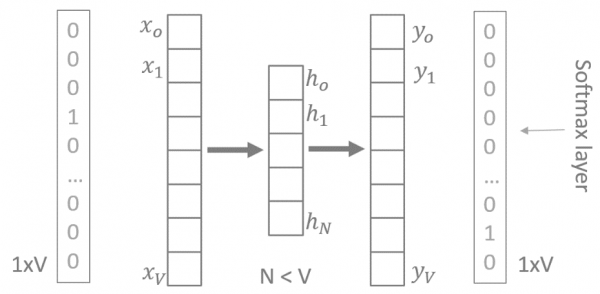
Figure 1: V-N-V neural architecture to predict a target word from a one-word context (CBOW) or a one-word context from a target word (skip-gram). Softmax activation functions in the output layer guarantee a probability compatible representation. Linear activation functions for the hidden neurons simplify the training computations.
Notice that the input and output layers have both dimension 1xV, where V is the vocabulary size since they both represent the one-hot encoding of a word. Notice also that the hidden layer has fewer units (N) than the input layer (V). So, if I represent the input word with the hidden neuron outputs rather than with the original one-hot encoding, I already reduce the size of the word vector, hopefully maintaining enough of the original information. The hidden neuron outputs provide the word embedding. This word representation, being much more compact than one-hot encoding, produces a much less sparse representation of the document space.
If we move to a bigger context — for example, with size C=3 — we need to slightly change the network structure. For the CBOW approach, we need C input layers of size V to collect C one-hot encoded word vectors. The corresponding hidden layer then provides C word embeddings, each one of size N. In order to summarize the C embeddings, an intermediate layer is added to calculate the average value of the C embeddings (Figure 2). The output layer tries to produce the one-hot encoded representation of the target word, with the same activation functions and the same error function as for the V-N-V network architecture in Figure 1.
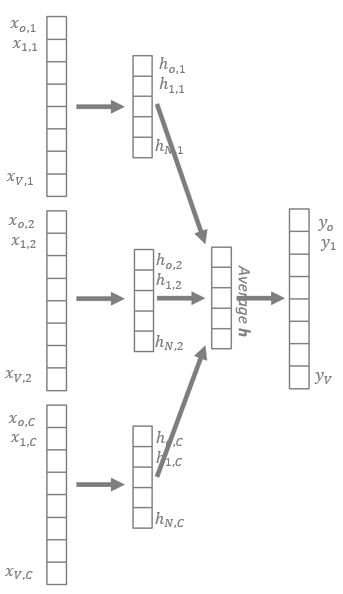
Figure 2: CBOW neural architecture with context size C=3.
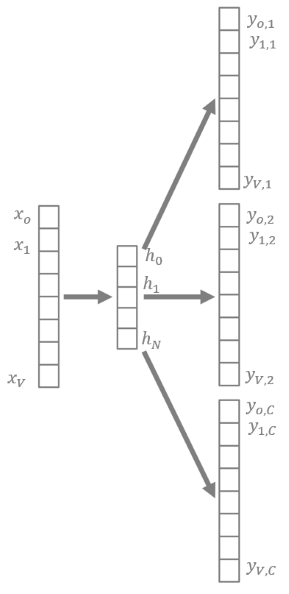
Figure 3: Skip-gram neural architecture with context size C=3.
A similar architecture (Figure 3) is created for the Skip-gram approach and context size C > 1. In this case, we use the weight matrix row, to represent the input word. Even here the word representation dimensionality gets reduced from V to N and the document space gets a more compact representation. This should help with upcoming machine learning algorithms, especially on large datasets and large vocabularies.
Word Survival Function
The vocabulary set can potentially become very large, with many words being used only a few times. Usually, a survival function examines all words in the vocabulary and decides which ones to keep. The survival function assumes the following form:

...where w is the word, z(w) is its frequency in the training set, and s is a parameter called sampling rate. The smaller the sampling rate, the less likely a word will be kept. Usually, this survival function is used together with a hard-coded threshold to remove very infrequent words.
Negative Sampling
Sometimes, in addition to the classic positive examples in the training set, negative examples are provided. Negative examples are wrong inputs for which no outputs can be determined. Practically, negative examples should produce a one-hot encoded vector of all 0s. The literature reports the usage of negative examples to help, even though a clear explanation of why has not been yet provided.
In general, the CBOW approach is already an improvement with respect to the calculation of a co-occurrence matrix since it requires less memory. However, training times for the CBOW approach can be very long. The skip-gram approach takes advantage of the negative sampling and allows for the semantic diversification of a word.
Representing Words and Concepts With Word2Vec
Word2Vec Nodes
In KNIME Analytics Platform, there are a few nodes which deal with word embedding.
The Word2Vec Learner node encapsulates the Word2Vec Java library from the DL4J integration. It trains a neural network with one of the architectures described above to implement a CBOW or a Skip-gram approach. The neural network model is made available at the node output port.
The Vocabulary Extractor node runs the network on all vocabulary words learned during training and outputs their embedding vectors.
Finally, the Word Vector Apply node tokenizes all words in a document and provides their embedding vector as generated by the Word2Vec neural network at its input port. The output is a data table where words are represented as sequences of numbers and documents are represented as sequences of words.
Words and Word Distances in the Embedding Space
The whole intuition behind the Word2Vec approach consists of representing a word based on its context. This means that words appearing in similar contexts will be similarly embedded. This includes synonyms, opposites, and semantically equivalent concepts. In order to verify this intuition, we built a workflow named 21_Word_Embedding_Distance and available on the EXAMPLES server under 08_Other_Analytics_Types/01_Text_Processing.
In this workflow, we train a Word2Vec model on 300 scientific articles from PubMed. One set of articles has been extracted using the query “mouse cancer” and one set of articles using the query “human AIDS”.
After reading the articles, transforming them into documents, and cleaning up the texts in the Pre-processing wrapped metanode, we train a Word2Vec model with the Word2Vec Learner node. Then, we extract all words from the model dictionary and we expose their embedding vectors, with a Vocabulary Extractor node. Finally, we calculate the Euclidean distances among vector pairs in the embedding space.

Figure 4: EXAMPLES/08_Other_Analytics_Types/01_Text_Processing/21_Word_Embedding_Distance workflow. This workflow analyzes the embedding vectors of all words in the dictionary produced by a Word2Vec model trained on a dataset of Pubmed scientific articles. These Pubmed articles deal either with human AIDS or with mouse cancer. Distances between embedding vectors of word pairs are calculated.
Synonyms, Concepts, and Semantic Roles
Figure 5 shows some results of this workflow, i.e. the positioning of some of the dictionary words in the embedding space using an interactive scatter plot. The interactive scatter plot allows for a drill-down investigation across all pairs of embedding coordinates. For the screenshot below, we chose embedding coordinates #3 and #10.
In the embedding coordinate plot, “cancer” and “tumor” are very close, showing that they are often used as synonyms. Similarly “AIDS” and “HIV” are also very close, as it was to be expected. Notice that “mouse” is in between “AIDS”, “cancer”, “tumor”, and “HIV”. This is probably because most of the articles in the data set describe mice related findings for cancer and AIDS. The word “patients”, while still close to the diseases, is further away than the word “mouse”. Finally, “women” are on the opposite side of the plot, close to the word “breast”, which is also plausible. From this small plot and small dataset, the adoption of word embedding seems promising.
You can explore the embedding space using different embedding coordinates in the scatter plot. Just select the menu icon in the top right corner in the view window generated by the Scatter Plot (JavaScript) node and change the x- and y-axis.
Note: All disease-related words are very close to each other, like, for example, “HIV” and “cancer”. Even if the words refer to different diseases and different concepts, like “HIV” and “cancer”, they are still the topic of most articles in the dataset. That is, from the point of view of semantic role, they could be considered equivalent and therefore end up close to each other in the embedding space.
Continuing to inspect the word pairs with the smallest distance, we find that “condition” and “transition” as well as “approximately” and “determined” are the closest words. Similarly, unrelated words such as “sciences” and “populations”, “benefit” and “wide”, “repertoire” and “enrolled”, “rejection” and “reported”, and “Cryptococcus” and “academy”, are located very closely in the embedding space.
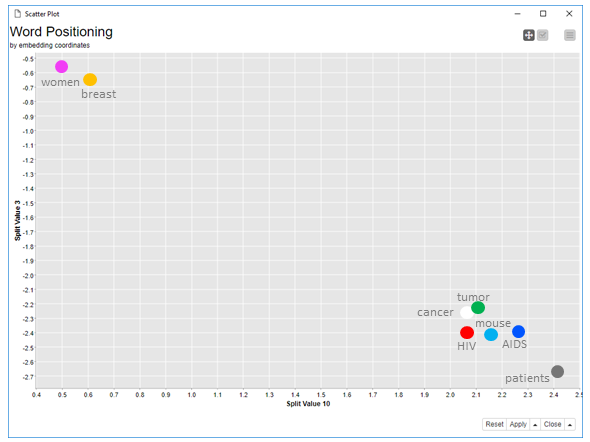
Figure 5: Scatter plot of word embedding coordinates (coordinate #3 vs. coordinate #10). You can see that semantically related words are close to each other.
Published at DZone with permission of Rosaria Silipo, DZone MVB. See the original article here.
Opinions expressed by DZone contributors are their own.

Comments